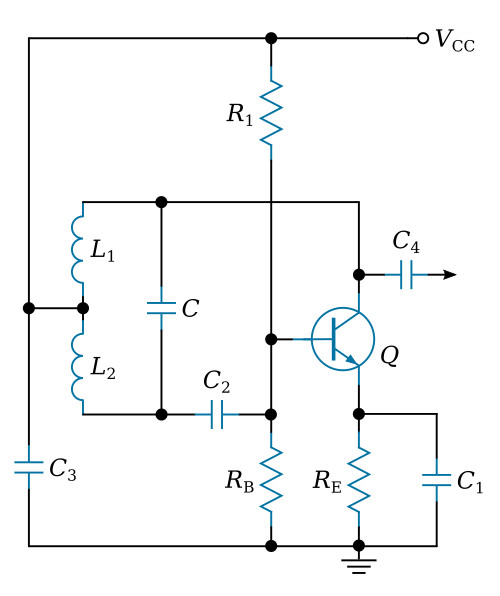Home > Textbooks > Basic Electronics > Oscillators > Hartley Oscillator >
Oscillators
Hartley Oscillator
The Hartley oscillator is an improvement over the Armstrong oscillator. Although its frequency stability is not the best possible of all the oscillators, the Hartley oscillator can generate a wide range of frequencies and is very easy to tune.
The Hartley oscillator uses an LC parallel-tuned circuit to establish the frequency of oscillation. The main difference between the Armstrong and the Hartley oscillators lies in the design of the feedback (tickler) coil. A separate coil is not used. Instead, in the Hartley oscillator, the coil in the tank circuit is a split inductor (or two inductors in series). The coil is usually wound continuously, since mutual inductance between the two portions of the inductor is not necessary for operation. Transistor operation is Class C for applications where waveform is not important, and Class A where waveform is important.
The LC circuit determines the frequency of oscillation. By using a tapped (split) inductor for the tank inductance, a portion of the tank voltage can be fed back to provide positive feedback and sustain oscillation.

The basic common-emitter configuration of the Hartley oscillator circuit is shown in the figure above. Bias arrangements are not shown, but will be discussed later. It is assumed that forward bias is initially applied to the emitter-base junction and that reverse bias is applied to the collector junction.
The discussion on the Armstrong circuit concerning the various configurations and the transistor action is applicable to this oscillator. The operation of the Hartley circuit, which has "tickler" coil as an integral part of its tuned-tank circuit, is similar as that of the Armstrong oscillator.
The Hartley circuit oscillates at

where M is the mutual inductance of L1 and L2.
Shunt-Fed Hartley Oscillator
The shunt-fed Hartley oscillator using the common-emitter configuration is shown in the figure below. One voltage supply is used, with fixed-bias being supplied by voltage-dividing resistors R1 and RB. Emitter-swamping resistor RE, bypassed by C1, is used for temperature stabilization.

The collector is shunt-fed through inductor L3, with C3 serving as the DC blocking and coupling capacitor to keep the tank coil from shorting the collector. Similarly, C2 serves as the base-blocking coupling capacitor to prevent shorting of the base to ground through the tank inductor.
When the shunt-fed circuit is energized, the initial bias is determined by R1 and RB, and oscillation is built up by feedback supplied from the collector to the base through sections L1 and L2 of the tank inductor. Note that an AC path exists from the emitter through the L1 portion of the tank and coupling capacitor C3 to the collector, and that a similar path exists through L2 and C2 to the base. As oscillation occurs, a degenerative bias is developed across RE (if C1 is the correct value). Usually, the values of voltage divider R1 and RB are chosen to provide Class A bias for easy starting, and the values of RE and C1 are chosen to provide thermal stabilization and Class B or C bias for the desired efficiency of operation. The output may be taken from a capacitor connected to the collector or from an inductor coupled to the tank.
Series-Fed Hartley Oscillator
The series-fed Hartley oscillator is shown in the figure below. The base circuit is voltage-divider biased and emitter-stabilized as in the shunt-fed version. The collector voltage is applied through the tap on the tank inductor, the voltage source being shunted for signal by C3. Operation of the series-fed circuit is otherwise identical with that of the shunt-fed circuit previously discussed. Since a DC current flows through a portion of the tank circuit, the Q factor is lowered and the oscillator frequency stability is not as as that of the shunt-fed circuit.







